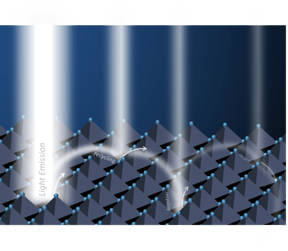Home > Press > Bioengineered nanoparticles show promise for fibrinogen manufacture, says Journal of Pharmaceutical Analysis study: Scientists engineer a nanoparticle polymer that can selectively bind to fibrinogen in human plasma, presenting a pathway for improved drug development
 |
| A novel bioengineered polymer that can selectively bind to fibrinogen in human blood could present a new solution for the manufacture of fibrinogen concentrate, with implications for its use in drug development, and further, in emergency medicine
CREDIT: Journal of Pharmaceutical Analysis |
Abstract:
A couple of essential biomolecules play a key role in the process of blood clotting. One of these is a protein called fibrinogen. It is often given to those who have experienced heavy bleeding, like trauma patients. But the fibrinogen concentrate that can be given to a patient is crude and involves a complicated purification process to be free of impurities and disease-causing organisms.
Bioengineered nanoparticles show promise for fibrinogen manufacture, says Journal of Pharmaceutical Analysis study: Scientists engineer a nanoparticle polymer that can selectively bind to fibrinogen in human plasma, presenting a pathway for improved drug development
Posted on January 14th, 2022
Addressing the need for better manufacturing processes, researchers from China and California developed a way to capture human fibrinogen from blood plasma. Kenneth J. Shea from the University of California, who is a corresponding author on this project, explains: We engineered a novel polymeric nanoparticle that can act as a protein affinity reagent, with selective affinity for human fibrinogen.
In their paper, which was made available online on 22 October 2020 in the Journal of Pharmaceutical Analysis, and published in Volume 11, Issue 5 in October 2021, they describe how the nanoparticles were made using temperature-sensitive N-isopropyl acrylamide (NIPAm) and L-amino acid monomers. Quanhong Zhu from Southern Medical University, China, who is also a corresponding author for the article, tells us: The polymerized forms of amino acids have great protein binding affinity, so by adjusting the formulation of a hydrogel by introducing these polymers, we can increase its protein binding affinity.
The researchers obtained functional monomers from five kinds of L-amino acids: L-phenylalanine (Phe) and L-leucine (Leu) with hydrophobic side chains, L-glutamic acid (Glu) with negative charges, and L-lysine (Lys) and L-arginine (Arg) with positive charges. Of these, the nanoparticles that incorporated N-acryloyl-Arg monomers showed the strongest and most specific binding affinity to fibrinogen after incubation.
The teams findings could fuel further research and development of as a fibrinogen-specific affinity reagent that could be used for drug manufacture. You can feel Zhus excitement as he elaborates: Our nanoparticles form non-biological protein affinity reagents, which are more robust and economic to manufacture than biological reagents. They have been specifically synthesized to bind to fibrinogen, and hence are also more efficient because they have greater binding capacity.
Fibrinogen concentrate can be quickly and safely given to patients in need, without the need for cross-matching. Its use in emergency medicine is undebatable. Now, the introduction of this synthetic, tailor-made reagent results in a simpler and less expensive way to manufacture fibrinogen concentrate, making it affordable and saving more lives!
***
Affiliations:
School of Traditional Chinese Medicine, Southern Medical University, Guangzhou, 510515, China
Guangdong Provincial Key Laboratory of Chinese Medicine Pharmaceutics, Guangzhou, 510515, China
Guangdong Provincial Engineering Laboratory of Chinese Medicine Preparation Technology, Guangzhou, 510515, China
Department of Chemistry, University of California, Irvine, CA, 92697, USA
About Professor Quanhong Zhu
Prof. Quanhong Zhu is affiliated to the School of Traditional Chinese Medicine at Southern Medical University, Guangzhou, China. His work at Guangdong Provincial Key Laboratory of Chinese Medicine Pharmaceutics and Guangdong Provincial Engineering Laboratory of Chinese Medicine Preparation Technology focuses on nanoparticles and drug development.
About Professor Kenneth J. Shea
Prof. Kenneth J. Shea is a distinguished professor of Chemistry who teaches at UC Irvine. He runs a research program that focuses on new material development. His own research interests include analytics, chemical biology, organic and synthetic polymers, materials, and nanoscience.
####
Contacts:
Fen Qiu
Journal of Pharmaceutical Analysis
Cell: +86-131-5206-8068
Copyright © Journal of Pharmaceutical Analysis
If you have a comment, please Contact us.
Issuers of news releases, not 7th Wave, Inc. or Nanotechnology Now, are solely responsible for the accuracy of the content.
News and information
![]()
Photon recycling The key to high-efficiency perovskite solar cells January 14th, 2022
![]()
NSF funds Rice effort to measure, preserve quantum entanglement: Physicist Guido Pagano wins CAREER Award to develop tools for quantum computing January 14th, 2022
![]()
Nanostructures get complex with electron equivalents: Nanoparticles of two different sizes break away from symmetrical designs January 14th, 2022
Possible Futures
![]()
UT Southwestern develops nanotherapeutic to ward off liver cancer January 14th, 2022
![]()
The free-energy principle explains the brain January 14th, 2022
Nanomedicine
![]()
UT Southwestern develops nanotherapeutic to ward off liver cancer January 14th, 2022
![]()
In vivo generation of engineered CAR T cells can repair a broken heart January 7th, 2022
Discoveries
![]()
UT Southwestern develops nanotherapeutic to ward off liver cancer January 14th, 2022
![]()
The free-energy principle explains the brain January 14th, 2022
![]()
JEOL Introduces New Scanning Electron Microscope with Simple SEM Automation and Live Elemental and 3D Analysis January 14th, 2022
Announcements
![]()
Nanostructures get complex with electron equivalents: Nanoparticles of two different sizes break away from symmetrical designs January 14th, 2022
![]()
UT Southwestern develops nanotherapeutic to ward off liver cancer January 14th, 2022
![]()
The free-energy principle explains the brain January 14th, 2022
Interviews/Book Reviews/Essays/Reports/Podcasts/Journals/White papers/Posters
![]()
Photon recycling The key to high-efficiency perovskite solar cells January 14th, 2022
![]()
Nanostructures get complex with electron equivalents: Nanoparticles of two different sizes break away from symmetrical designs January 14th, 2022
Nanobiotechnology
![]()
UT Southwestern develops nanotherapeutic to ward off liver cancer January 14th, 2022
![]()
In vivo generation of engineered CAR T cells can repair a broken heart January 7th, 2022










